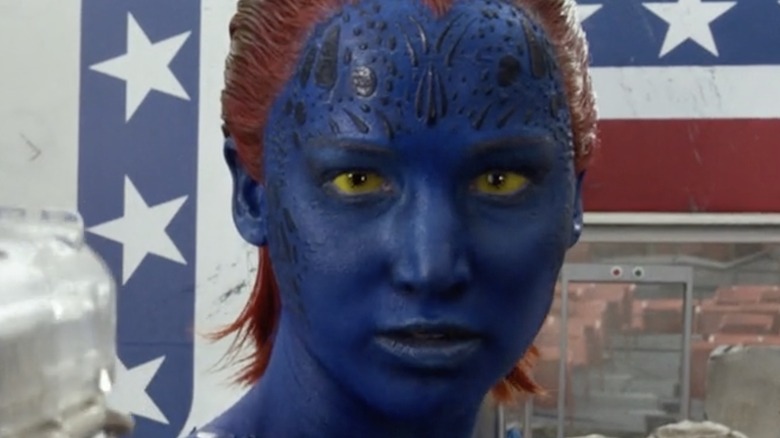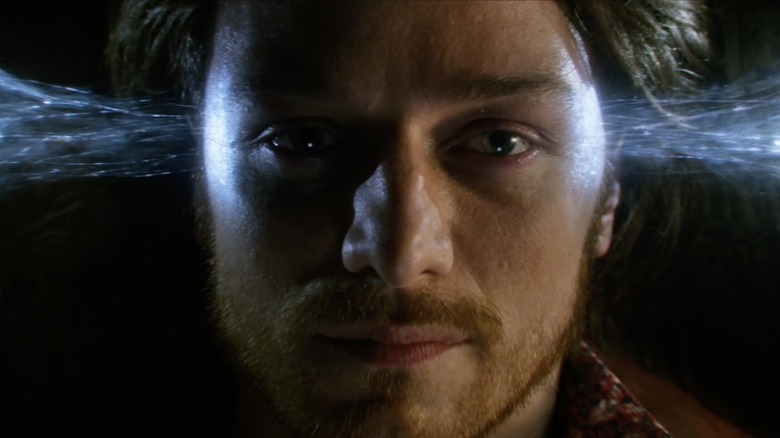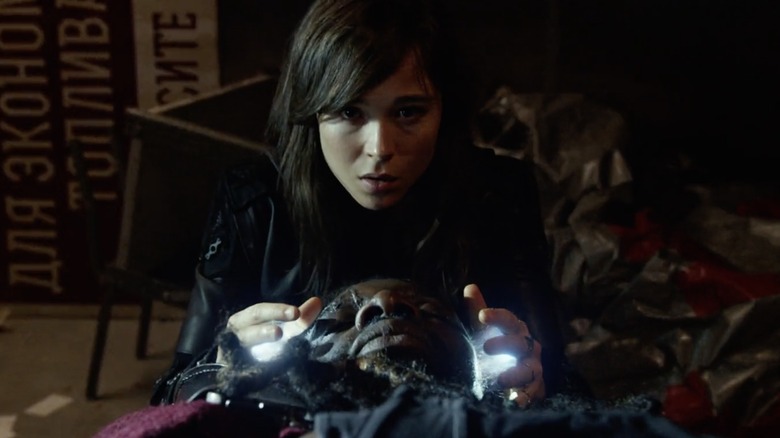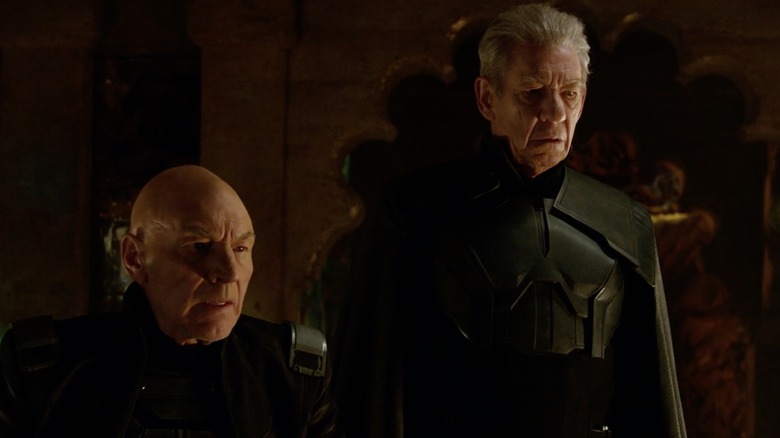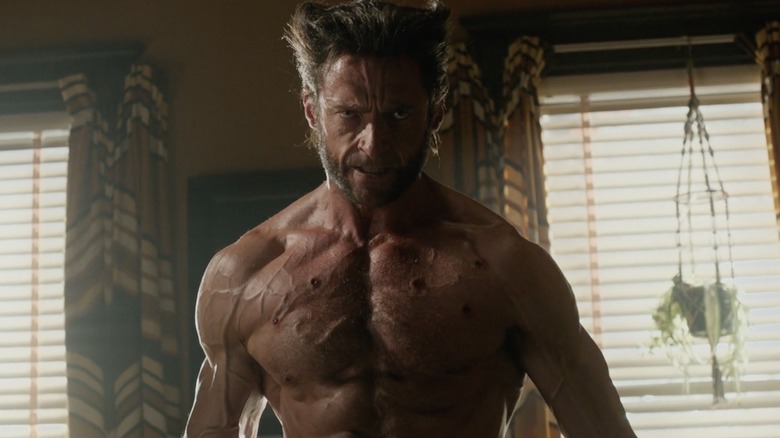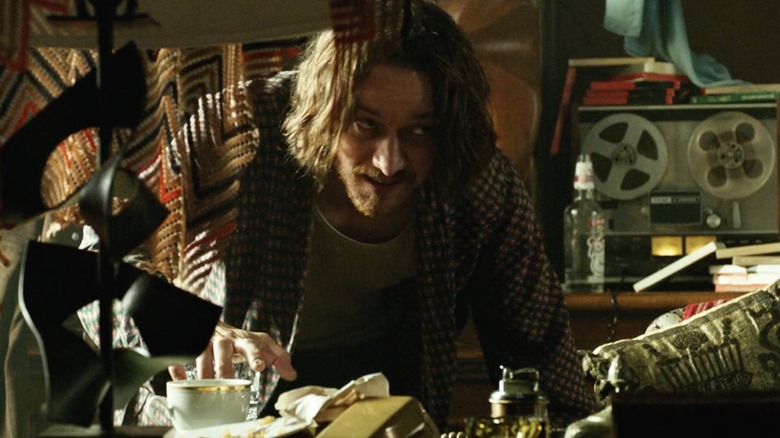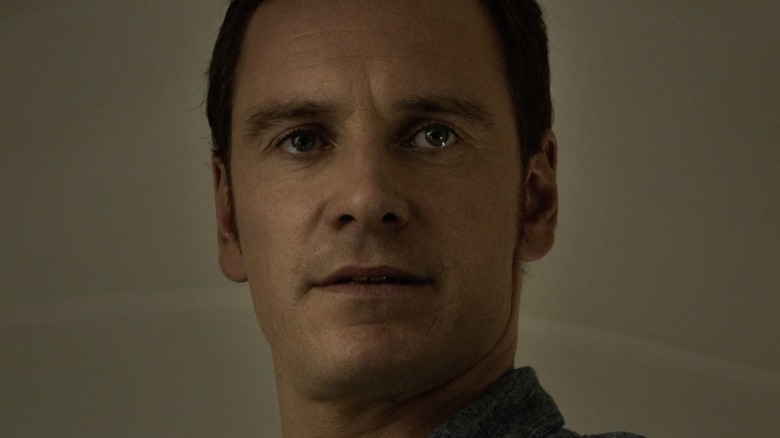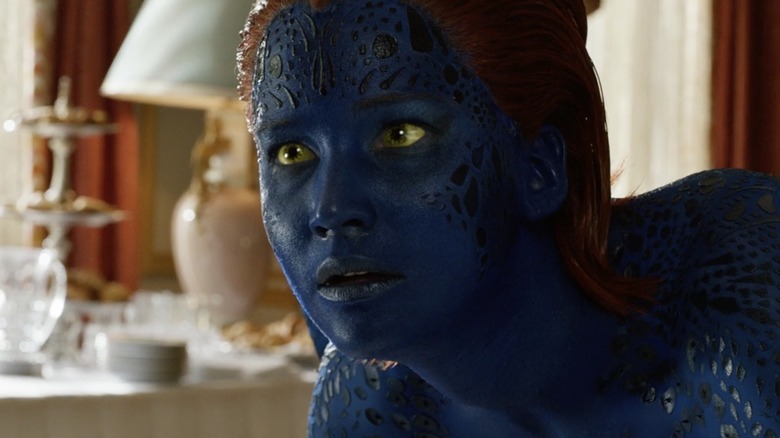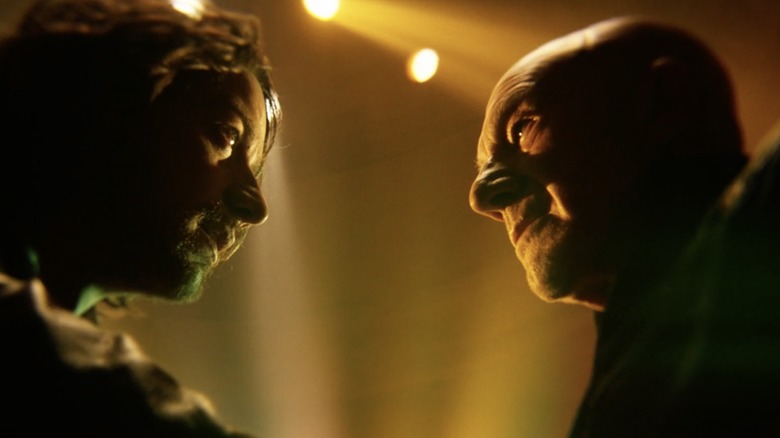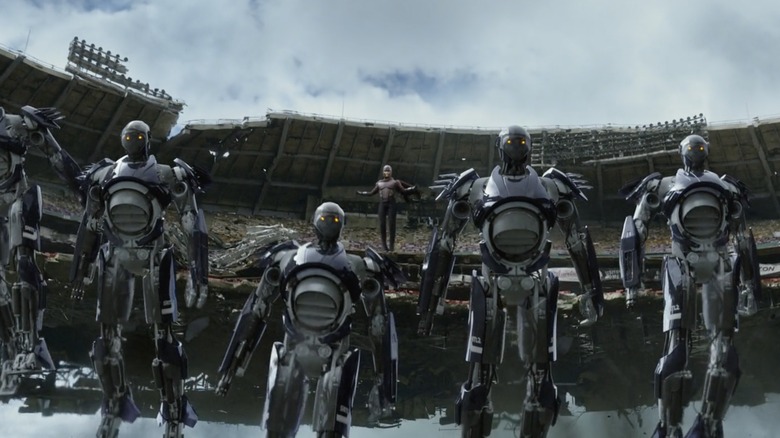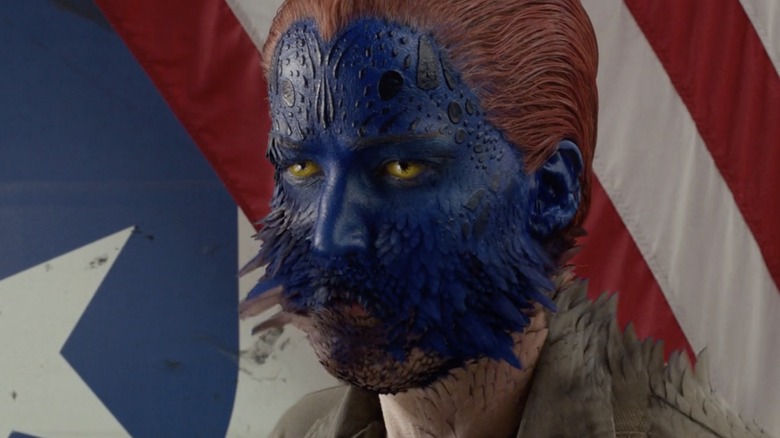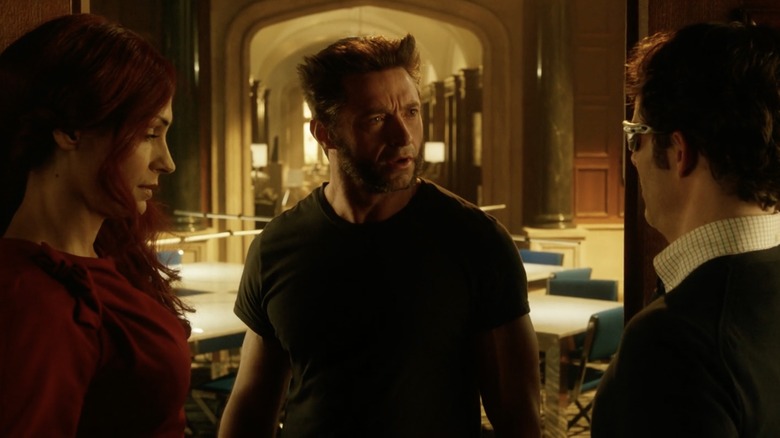The Ending Of X-Men: Days Of Future Past Explained
Just before the dawn of the current millennium, the public was still reeling from George Clooney's rubber-nipple-clad Batman and the phrase "Iron Man" was primarily associated with Black Sabbath. Suddenly, the modern-day superhero era took a leap forward with the arrival of "X-Men" in 2000. The film's success led to sequels, which led to prequels, which led to a hectic, self-contradicting timeline containing multiple versions of our favorite mutants.
The X-Men timeline desperately needed to sync up at one point, and 2014's "X-Men: Days of Future Past" was the vehicle that helped mash together the multiple versions of "X-Men" history. Its merging of the stars from the 2011 soft reboot "X-Men: First Class" with the original cast made for an entertaining and slightly confusing watch. Time travel is a messy business, and the mechanics at play in "Days of Future Past" are anything but traditional. Assuming Marvel continues to fold previously existing timelines into present-day movie storylines, it is important that we get our facts straight. One of the most pivotal storylines in the "X-Men" multiverse takes place in "Days of Future Past." We are here to explain the film's climactic ending.
The mechanics of mutant time travel
For the most part, film viewers have resolved themselves to the basic time traveling rules of "Back to The Future." We recommend tossing aside all such whimsical simplicity. The time traveling in "Days of Future Past” is a unique beast. It primarily involves a mutant named Kate "Kitty" Pryde (Elliot Page). Normally, the mutant formerly codenamed Shadowcat has the ability to move though solid objects — walk through walls, essentially — and can bring others along if need be.
In the original "Days of Future Past" two-issue story by Chris Claremont and John Byrne published in 1981, Rachel Summers — a very powerful telepathic character who has yet to appear in any movies — sends the consciousness of a middle-aged Kate Pryde back to inhabit her teenage self to warn the past X-Men about upcoming events that lead to the mutant-slaughtering Sentinels conquering the United States.
The movie "Days of Future Past" loosely applies this plot point by giving Page's Kate telepathy-adjacent powers to send Wolverine on a mission to the '70s via consciousness-transplanting, similar to Kate's comic book counterpart's adventure in Claremont's "Days of Future Past." Thanks to Logan's regenerative abilities, he doesn't really age, which allows Hugh Jackman to play Logan in the dystopian future as well as the 1970s. The two points in history — the grim future inhabited by the cast of 2000's "X-Men," and the past inhabited by the "First Class" crew – exist in unison throughout the events of "Days of Future Past," because Logan's consciousness from the future is occupying his body in the past. That's simple enough, right?
What in the time blip just happened?
Most of "Days of Future Past" takes place in 1973, but the film opens within an apocalyptic version of 2023. We have the pleasure of seeing some of our favorite mutants dance across the screen. Colossus (Daniel Cudmore) glimmers with his impervious muscles. Iceman (Shawn Ashmore) hurls frozen water at will. Blink (Bingbing Fan) — making her first movie appearance — has the ability to throw open translocation portals. Before we have time to soak up their grandeur, massive Sentinels with powerful T-1000 vibes show up and massacre just about every mutant in the vicinity ... except Kate Pryde and Bishop (Omar Sy), thankfully.
Kate uses her powers to send Bishop back in time a few days to warn these X-Men of the impending attack by the Sentinels. The visual representation of this activity is displayed as the screen seemingly disappearing all the characters and restoring the surroundings to their pre-destruction state. This shows us that time has been altered and the calamity the audience just watched has been avoided entirely. This is how Kate, Iceman, Bishop, and their cohort of X-Men have stayed alive in this future.
We can't run forever
The original comic book version of the Sentinels are mostly only a threat to the X-Men if they attack in large numbers. Cyclops can usually decimate a single comic book Sentinel by himself without too much trouble, for example. The movie version of the fascist death-bots are a functionally unstoppable other matter entirely. Their technology allows them to mimic any mutant abilities they come across — think Mystique's morphing ability, but for using any mutant power instead of merely shape-shifting. These Sentinels have been mass produced and overwhelm humanity and mutantkind alike in a manner that Skynet would envy.
The X-Men have barely managed to stay a step ahead of impending doom. Professor Xavier (Patrick Stewart) and Magneto (Ian McKellen) are wizened and exhausted from years of combating the onslaught. They are searching for a way to end the war. When they learn more details about Kate's abilities, a plan is formulated. The plan involves sending someone back to 1973 to stop the Sentinels from ever being created. There is a slight problem, though. In 1973, the X-Men are in shambles: Xavier (James McAvoy) is still grappling with his newfound paralysis, Magneto (Michael Fassbender) is locked in a plastic prison deep under the Pentagon, and Mystique (Jennifer Lawrence) is traversing the world battling mutant oppression. The circumstances would make Xavier the best option to send back in time, given his diplomatic prowess, but fate has other plans. Sending someone back that far would shred their psyche. No one could survive the journey ... Except of course for the franchise's regenerative de facto protagonist, Wolverine.
Logan is the man for the job
Logan is now charged with the fate of the entire world. He has his mission parameters and lays down on a slab to allow Kate to transport his consciousness back to 1973. After a slightly painful journey through time, Logan wakes up facing a long-lost relic of the past — a lava lamp. The Wolverine shown in this scene is arguably the most insanely jacked we've ever seen Hugh Jackman as his career-defining character. A typical human does not have veins protruding from their pectorals. From bicep to glute, the Wolverine of 1973 appears to be very much a superhero in his prime. The sinewy fibers of his Adonis-like physique ripple in the sunlight and ... hold on, we're getting distracted. Let's refocus.
After a brief encounter with some local thugs, Logan ventures out into the '70s. He needs to prevent Mystique from falling into the hands of the government. This is scheduled to occur after she assassinates a military scientist named Bolivar Trask (Peter Dinklage). The event leads to her capture and the advancement of the Sentinel program. Mystique's DNA contains the data that allows Sentinels to mimic deadly mutant abilities. It is imperative that Logan not allow Mystique to get captured. But Mystique is stubborn, and she just learned that Trask is experimenting on mutants, which makes her very unhappy.
Young Xavier doesn't have his act together
To find Mystique, Wolverine will need some help. Logic tells us the first move would be to recruit the man who usually does the recruiting — Professor Charles Xavier. Once Wolverine's '70s crew has the world's most powerful telepath on board, the crisis should be averted fairly quickly, right? The man has the ability to control people's minds and freeze time, after all. But there is a major problem. Professor X is residing in an empty schoolhouse drinking away his sorrows and pumping himself full of a serum that mutes his abilities. He is hardly reminiscent of the once mighty mutant leader with the most powerful mind on Earth.
The only way Logan is able to convince Xavier of his temporal displacement is through the retelling of a personal story Professor X previously thought untold. And since it happens to be the case that Professor X wishes to reunite with Mystique anyway, he joins Logan's cause. Wolverine has taken the first step required to save the world from the Sentinels. Meanwhile in the future, the Sentinels spot the location of the X-Men. Unlike the beginning of the movie, this time Kate is unavailable to warn earlier versions of the X-Men of the incoming threat because keeping Logan's consciousness in 1973 requires all her focus.
Magneto the jerk
The X-Men of 1973 know that the only way Mystique will listen to reason is if she sees Magneto and Professor X working together again, like they do in "First Class." The audience knows the two of them ultimately wind up on the same team, as we see them on the same side in the future. To achieve this end, Logan and the gang will have to wrangle up the angsty metal manipulator. Magneto is being held deep under the Pentagon in a maximum-security plastic prison. Luckily for everyone involved, Logan knows a speedster by the name of Peter Maximoff (Evan Peters). He also goes by the name "Quicksilver" under the proper circumstances.
Watching Peter zip around the room and essentially run circles upon circles around Logan, Professor X, and Beast (Nicholas Hoult) leaves an impression that there isn't much any other mutant could do against him. It's hard to say exactly why he isn't a more formidable component in the "X-Men" series at this point. Perhaps his virtual omnipotence has left him with some of the existential ennui associated with Dr. Manhattan of "Watchmen" fame? Anyways, the X-Men with Peter's help break Magneto out of prison. The crew have all the components they need to track down and persuade Mystique to change the course of history. But there's yet another problem — Magneto is a jerk.
Different reality, same results
Originally, Mystique assassinates Trask at the Paris Peace Accords. The '70s X-Men position themselves to prevent this from occurring, unaware that one amongst them has his own agenda. Magneto reasons that he can avert the catastrophic future by simply killing Mystique, thereby preventing any possibility of the government capturing her and researching her DNA to make the Sentinels. Mystique escapes Magneto's attempt to shoot her, leaving a trail of mayhem in her wake, which gives her the opportunity for another swing at assassinating Trask.
During this encounter, Logan's connection between his past and future self is briefly disrupted. You might expect the future to change at this moment, since Trask survived Mystique's attempt on his life. But the government gets Mystique's DNA from her blood left behind at the scene of her escape, and the results for the future remain largely the same ... Except now, a crowd of people in the '70s saw Magneto, Beast, and Mystique fighting in the middle of the street, which probably left them with some newfound questions and concerns regarding folks with superpowers.
Preparing for the worst
After the disastrous attempt to persuade Mystique to not kill Trask, every major player regroups. Magento runs off to get his helmet. Mystique positions herself for another assassination attempt. And Professor X traverses the psychic landscape to communicate with an older version of himself. He stops taking the serum dampening his abilities and dives into Logan's mind. Charles is able to follow the mental connections through time to have a chat with the future version of himself played by Patrick Stewart. The conversation renews past Professor X's vigor, and he uses Cerebro to gather necessary data to find Mystique. Every character element comes into play during a press conference outside the White House.
So far, the future remains the same way it looked at the start of the movie. Sentinels will still be created and Mystique's DNA will advance them to a state of near invincibility. Adding insult to injury, in the future, the Sentinels have found the location of the X-Men. This development threatens to sever Logan's connection to the past before he can change the future.
If at first you don't assassinate, try and try again
Mystique is a tenacious mutant. If she commits to putting a bullet between the eyes of some nerd who makes killer robots, then by golly, that nerd is toast. Unfortunately, Trask has cozied up to the president of the United States — a notoriously well-guarded individual. Fortunately for Mystique, she can shape shift into a member of the Secret Service and effortlessly glide right by some of the most comprehensive security measures on the planet.
During the climatic White House press conference, things seem to be under control when Professor X telepathically grabs hold of Mystique to restrain her. A safe and secure future is ensured, until Magneto takes control of the Sentinels and plops a colosseum around the White House, trapping Xavier under scaffolding and forcing the POTUS and Trask to hide in an underground bunker with an undercover Mystique. The Secret Service discover a mutant is in their midst and capture Mystique, apparently guaranteeing the future both sets of X-Men in this movie have been trying to prevent. Adding insult to injury, Magneto weaves steel rebar into Logan and chucks him into a nearby river. Meanwhile, the future X-Men are fighting a losing battle against the Sentinels.
A chance to choose your own destiny ... again
All the events of "Days of Future Past" culminate in one pivotal moment — when Magneto is about to unleash his fury with an entire arsenal of guns aimed at the president and his cabinet. The cameras are still rolling from the live television broadcast of the ceremony, and Magneto takes this moment to step on a soap box. Lucky for President Nixon, Mystique decides to subdue Magneto. When she turns to kill Trask, time stands still. There is a brief pep talk from Professor X before he relinquishes his hold on the moment and lets Mystique make her own decision.
Mystique decides to walk away, essentially leaving the entire world to think they just saw the president saved by a mutant. This leads to the dismantling of the Sentinel program, undoing the bleak future. In the future, this alteration to history is displayed the same way we see Kate and other X-Men escape death at the beginning of the movie — with a wipe of characters off the screen.
Meanwhile, the link between Logan's future and past self is broken. Logan's 1973 self is trapped in rebar at the bottom of the river, where he is apparently discovered by Major Bill Stryker (Josh Helman) — the man responsible for the experiments that give Wolverine his adamantium.
Logan wakes up in a different year
We've all had some intense naps. Those heavy slumbers that have you snapping awake at 3 p.m., forgetting what year it is. They are a marriage of glory and terror. As magnificently disorienting as those naps can be, they are nothing compared to what Logan wakes up to in his new future.
Logan's beloved Jean Grey (Famke Janssen) is alive again along with Cyclops (James Marsden), Rogue (Anna Paquin), and all the other X-Folks. The reunion is painted against the backdrop of a bustling Xavier's School for Gifted Youngsters in all its oak-lined glory.
Logan is the only person who remembers the changes made to the world. The past version of himself lived onward from 1973 until this moment in 2023 when his consciousness was returned to its original temporal designation. The only other person alive who can understand Logan's mental state is Professor X. He didn't know exactly when, but he knew at some point in time the version of Wolverine he met in 1973 would re-emerge. And here he is at the end of "Days of Future Past," in desperate need of a history lesson.
